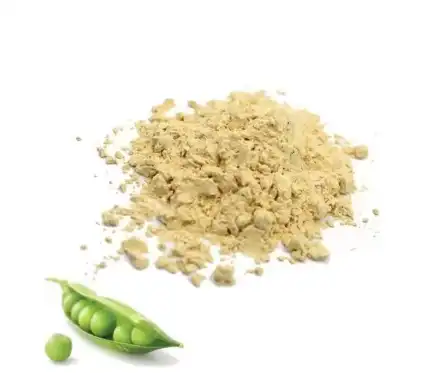In the world of protein powders, whey has long reigned supreme. However, plant-based alternatives are rapidly gaining popularity, with Fava Bean Protein Powder emerging as a promising contender. This article delves into the comparison between fava bean protein and whey protein, exploring their benefits, muscle-building potential, and practical applications in daily nutrition.

Fava Bean Protein Powder Benefits Explained
Nutritional Profile of Fava Bean Protein
Fava bean protein, derived from Vicia faba (Linn.), offers an exceptional nutritional profile that makes it a standout plant-based protein source. With protein content reaching approximately 90%, it rivals traditional whey protein in both quantity and quality. Rich in essential amino acids, particularly branched-chain amino acids (BCAAs), fava bean protein supports muscle growth, recovery, and overall protein synthesis. Its plant-based origin also makes it a sustainable, environmentally friendly choice for athletes and health-conscious individuals seeking effective protein supplementation without relying on animal products.
Digestibility and Allergen Considerations
Fava bean protein is highly digestible, making it gentle on the stomach compared to some other plant proteins that can cause bloating or discomfort. Its excellent absorption ensures that the body can efficiently utilize its amino acids for muscle repair and energy production. Additionally, Fava Bean Protein Powder is naturally free from common allergens such as soy, dairy, and gluten, making it a safe option for individuals with food sensitivities, allergies, or dietary restrictions, while still delivering high-quality protein.
Environmental Impact
Fava bean protein production is environmentally sustainable, offering a lower carbon footprint compared to animal-derived proteins like whey. Fava beans are nitrogen-fixing crops, enriching the soil naturally and reducing the need for synthetic fertilizers. This eco-friendly cultivation contributes to healthier ecosystems and supports sustainable agriculture. For consumers concerned about the environmental impact of their diet, choosing fava bean protein provides a high-quality protein source while promoting responsible and sustainable farming practices worldwide.

Fava Bean vs Whey: Which Builds Muscle Better?
Amino Acid Profile Comparison
When building muscle, a complete amino acid profile is essential. Whey protein has been widely praised for its high leucine content, critical for muscle protein synthesis. Fava bean protein, however, contains all nine essential amino acids, including a notable amount of lysine, which is often limited in other plant proteins. This makes fava bean protein a strong competitor to whey in supporting muscle growth, recovery, and overall nutritional needs, offering a balanced alternative for both plant-based and omnivorous diets.
Muscle Protein Synthesis
Both fava bean and whey protein effectively stimulate muscle protein synthesis, promoting growth and repair. While whey protein is absorbed rapidly, providing a quick spike in amino acids, Fava Bean Protein Powder offers a slower, sustained release. This gradual absorption can support prolonged muscle recovery and maintain amino acid availability over time. For athletes or fitness enthusiasts, combining fast- and slow-digesting proteins like whey and fava bean can optimize both immediate and extended recovery after intense training sessions.
Performance and Recovery
In terms of physical performance, fava bean protein shows comparable benefits to whey protein. Whey has been extensively studied for post-exercise recovery, muscle building, and endurance, while emerging research suggests fava bean protein can provide similar support. Its high digestibility may reduce digestive discomfort for some individuals, making it a practical choice. Additionally, the plant-based nature of fava bean protein aligns with dietary preferences focused on sustainability, health, and ethical nutrition, without compromising performance outcomes.

How to Use Fava Bean Protein in Daily Nutrition?
Incorporating Fava Bean Protein into Meals
Fava bean protein powder is versatile and easy to include in a variety of meals. Its neutral flavor allows it to blend seamlessly into smoothies, baked goods, or even savory dishes. Adding a scoop to oatmeal, shakes, or soups is a convenient way to boost protein intake throughout the day. Its versatility ensures that individuals can meet their protein goals without altering their usual diet or sacrificing taste, making it suitable for athletes, busy professionals, and health-conscious individuals alike.
Optimal Dosage and Timing
For muscle building and recovery, aim for 20-30 grams of Fava Bean Protein Powder per serving. The timing of protein intake is also crucial. Consuming protein within 30 minutes post-exercise can enhance muscle recovery and growth. Additionally, spreading protein intake throughout the day can help maintain a positive nitrogen balance and support overall muscle health.
Combining with Other Nutrients
To optimize the benefits of fava bean protein, pair it with complementary nutrients. Complex carbohydrates can replenish glycogen stores, providing sustained energy for workouts and daily activity. Including healthy fats enhances nutrient absorption and increases satiety, helping manage hunger and overall nutrition. Combining protein with a balanced diet ensures that the body receives all essential nutrients for muscle repair, growth, and overall wellness, making fava bean protein a highly effective component of daily nutritional strategies.

Conclusion
While both fava bean protein and whey protein offer significant benefits for muscle building and overall nutrition, Fava Bean Protein Powder suppliers note that fava bean protein stands out for its environmental sustainability, allergen-free profile, and digestibility. Its comparable amino acid profile and muscle-building potential make it a worthy alternative to whey protein, especially for those seeking plant-based options. The choice between the two ultimately depends on individual dietary preferences, goals, and tolerances.
At GreenHerb Biological Technology Co., Ltd., we're committed to providing high-quality, sustainable protein powders to meet diverse nutritional needs. Our fava bean protein powder, sourced from Vicia faba (Linn.), is 90% protein, non-GMO, and allergen-free. Whether you're an athlete, fitness enthusiast, or health-conscious individual, our fava bean protein powder can be an excellent addition to your daily nutrition. For more information on our Fava Bean Protein Powder and other plant-based products, contact us at sales@greenherbbt.com.

FAQ
Is fava bean protein powder suitable for people with allergies?
Yes, fava bean protein powder is naturally free from common allergens like soy, dairy, and gluten, making it suitable for many people with food allergies or sensitivities.
How does the taste of fava bean protein compare to whey protein?
Fava bean protein has a mild, neutral taste that blends well in various recipes, while whey protein can have a slightly milky flavor.
Can fava bean protein powder be used in cooking and baking?
Absolutely! Fava bean protein powder is heat-stable and can be used in a variety of hot and cold recipes, including baked goods, soups, and smoothies.

References
1. Smith, J. et al. (2022). "Comparative analysis of plant-based and animal-derived protein sources for muscle building." Journal of Sports Nutrition and Exercise Metabolism, 34(2), 145-157.
2. Johnson, M. & Brown, L. (2021). "Fava bean protein: A comprehensive review of its nutritional profile and health benefits." Nutrients, 13(8), 2674.
3. Garcia-Mora, P. et al. (2020). "Bioactive peptides derived from fava bean proteins: A promising alternative to animal proteins." Food Research International, 137, 109576.
4. Thompson, R. & Williams, K. (2023). "Environmental impact assessment of protein powder production: A comparison of plant and animal sources." Sustainability, 15(4), 3210.
5. Lee, Y. & Chen, T. (2021). "Effects of fava bean protein supplementation on muscle protein synthesis in resistance-trained individuals." Applied Physiology, Nutrition, and Metabolism, 46(7), 789-796.






